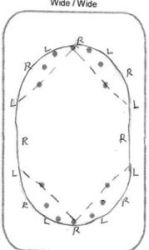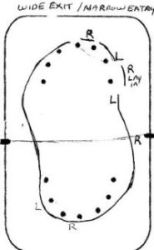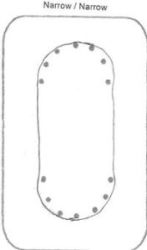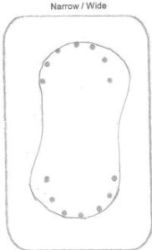Tracks
By Susan Ellis, January 2005
Short track skating is a sport of many skills and abilities. Not only do skaters have to be in great shape, but also they need great technical, strategical, and tactical skills. Skaters are presented with a multitude of changing situations over the course of a race where the ability to adapt to the situation is critical.
The ability to change one’s track pattern may mean the difference between making the pass, blocking a pass, catching up, breaking away, conserving energy or using too much energy.
There are so many different track patterns, each with its own purpose, that it would take many more pages than we have space here to discuss them all, but this outlines a few of the basic tracks.
The ability to change one’s track pattern may mean the difference between making the pass, blocking a pass, catching up, breaking away, conserving energy or using too much energy.
There are so many different track patterns, each with its own purpose, that it would take many more pages than we have space here to discuss them all, but this outlines a few of the basic tracks.

Wide / Wide
A wide/wide track means you are entering the corner wide and exiting wide. It is the track where you can attain the highest speeds because you are not fighting centrifugal force as much as you are widening the radius. It is therefore a good track for the opening laps of a time trial, when trying to break away, or when chasing.
How wide you enter and exit is dependent on your top speed. The faster you go, the wider you need to enter.
The number of strides is also speed dependent. Younger skaters may need 3 crossovers in and 3 crossovers out, while older skaters may need 2 in and 2 out.
The Entry:
Stand on the track near the entry so that you are half way between the boards and the track and look at the first block. Now move yourself in to a position where you can draw a straight line from yourself, to the first block, to the apex block. This is generally where your left skate needs to land for your first left leg push. (Remember to land it so you are already leaning in to the turn.)
Your crossovers should gradually take you on an arc in towards the apex block. A common error is to come in to the second block too soon with the first right cross. You should not be right on the blocks until the 3rd block.
Your second right cross lands in between the 3rd and 4th blocks so the tip of your right blade is almost in line with the apex when it lands. Your blade should be pointing toward the side boards, not the end boards.
Your exit path should take you away from the blocks on the same arc as you entered. You should be close to the 5th block and then allow yourself to drift off blocks 6 and 7.
Maintain your lean right through the landing of your right foot for your first straightaway stride. A common error is to straighten up too soon forcing you to start the straightaway too soon. Actually you should think of this first right straight as a corner stride because you are still leaning when you take it, but for simplicity we’ll call it a straight stride.
From the exit it is a fairly straight line to the entry point for the next corner. Older skaters need only 2 straightaway strides, while younger skaters may need 4.
On any track a consistent stride pattern is essential to get the maximum speed out of that track. Counting the number of strides out loud can help, as well as being aware of your entry point, and exit point.
The advantage of this track, as I mentioned, is speed. The disadvantage is that it leaves room for people to pass on the exit as well as a late pass on the entry.
A wide/wide track means you are entering the corner wide and exiting wide. It is the track where you can attain the highest speeds because you are not fighting centrifugal force as much as you are widening the radius. It is therefore a good track for the opening laps of a time trial, when trying to break away, or when chasing.
How wide you enter and exit is dependent on your top speed. The faster you go, the wider you need to enter.
The number of strides is also speed dependent. Younger skaters may need 3 crossovers in and 3 crossovers out, while older skaters may need 2 in and 2 out.
The Entry:
Stand on the track near the entry so that you are half way between the boards and the track and look at the first block. Now move yourself in to a position where you can draw a straight line from yourself, to the first block, to the apex block. This is generally where your left skate needs to land for your first left leg push. (Remember to land it so you are already leaning in to the turn.)
Your crossovers should gradually take you on an arc in towards the apex block. A common error is to come in to the second block too soon with the first right cross. You should not be right on the blocks until the 3rd block.
Your second right cross lands in between the 3rd and 4th blocks so the tip of your right blade is almost in line with the apex when it lands. Your blade should be pointing toward the side boards, not the end boards.
Your exit path should take you away from the blocks on the same arc as you entered. You should be close to the 5th block and then allow yourself to drift off blocks 6 and 7.
Maintain your lean right through the landing of your right foot for your first straightaway stride. A common error is to straighten up too soon forcing you to start the straightaway too soon. Actually you should think of this first right straight as a corner stride because you are still leaning when you take it, but for simplicity we’ll call it a straight stride.
From the exit it is a fairly straight line to the entry point for the next corner. Older skaters need only 2 straightaway strides, while younger skaters may need 4.
On any track a consistent stride pattern is essential to get the maximum speed out of that track. Counting the number of strides out loud can help, as well as being aware of your entry point, and exit point.
The advantage of this track, as I mentioned, is speed. The disadvantage is that it leaves room for people to pass on the exit as well as a late pass on the entry.

Wide / Narrow
A wide/narrow track means you are exiting wide and entering narrow.
It is a good track for higher speeds, but also affords good blocking of passes at the same time as you are blocking the track from about the red line to the entry. You are, however compromising your speed slightly on the entry because of the narrower path in and you are also taking one less stride in to the apex. It is a good track to use later on in a race when you need to block passes but still maintain high speed, or when fatigue starts to set in and it is hard to maintain tempo on the 2 cross in.
Generally you would take 1 crossover in to the apex, short pivot, and 2 or 3 crosses out.
Walk through this:
Stand on the red line so you are in a direct line with the 1st block. Now move straight down the track to just a few feet before the block. This is where your left straightaway push would lift off the ice. Your right passes a few feet off the first block, not right on it. Your left lands at or just after the second block, and your right lands between blocks 3 and 4 (closer to block 4). From there you allow yourself to drift off the blocks the same as for the wide exit above.
The goal of this wide exit is to get you as far as possible down the straightaway and bring you on closer to the center of the ice on the last left leg push and right cross. It is critical to maintain your lean and keep your weight coming forward to the ball of your foot to push so you maintain, or even increase your speed, and to be able to carve back in to the center.
The advantage of this track is high speed on the exit, making it difficult to pass. It also conserves a bit of energy, as there is one less crossover in to the apex.
The disadvantage is of course the vulnerability to a pass if your speed is not high enough on the exit and a skater goes by you before you have had a chance to come back in to block the latter part of the straightaway. It is also a track that can lead to cross tracking calls if you are not careful not to come back in when someone has already started to pass you.
A wide/narrow track means you are exiting wide and entering narrow.
It is a good track for higher speeds, but also affords good blocking of passes at the same time as you are blocking the track from about the red line to the entry. You are, however compromising your speed slightly on the entry because of the narrower path in and you are also taking one less stride in to the apex. It is a good track to use later on in a race when you need to block passes but still maintain high speed, or when fatigue starts to set in and it is hard to maintain tempo on the 2 cross in.
Generally you would take 1 crossover in to the apex, short pivot, and 2 or 3 crosses out.
Walk through this:
Stand on the red line so you are in a direct line with the 1st block. Now move straight down the track to just a few feet before the block. This is where your left straightaway push would lift off the ice. Your right passes a few feet off the first block, not right on it. Your left lands at or just after the second block, and your right lands between blocks 3 and 4 (closer to block 4). From there you allow yourself to drift off the blocks the same as for the wide exit above.
The goal of this wide exit is to get you as far as possible down the straightaway and bring you on closer to the center of the ice on the last left leg push and right cross. It is critical to maintain your lean and keep your weight coming forward to the ball of your foot to push so you maintain, or even increase your speed, and to be able to carve back in to the center.
The advantage of this track is high speed on the exit, making it difficult to pass. It also conserves a bit of energy, as there is one less crossover in to the apex.
The disadvantage is of course the vulnerability to a pass if your speed is not high enough on the exit and a skater goes by you before you have had a chance to come back in to block the latter part of the straightaway. It is also a track that can lead to cross tracking calls if you are not careful not to come back in when someone has already started to pass you.

Narrow / Narrow
This means you are exiting narrow and entering narrow. It is the track that requires the most energy because you are skating a narrower radius and it takes energy to fight centrifugal force, but is a good blocking track for the end of races where you want to prevent inside passes. The problem with this track is that you are vulnerable to outside passes because your speed is compromised because you are not leaning as much on both the entry and the exit. Because you are not leaning as much, you are reducing the number of crossovers and may need to add another set of straightaway strides and straightaway strides are generally slower than crossovers. Your weight transfer on the straight is also compromised because you can’t lean and load your pushes as much as it might open the door to a pass.

Narrow / Wide
A narrow/wide track means you are exiting narrow and entering wide.
It is normally a track for younger skaters and is not often seen at the higher levels, but is a good track to learn blocking skills on the exit and high speed entry skills.
The entrance is set up the same as for a wide/wide track. On the exit the skater stays very close to the blocks right through to the last block to make sure there is no room for someone to sneak in a pass.
It then depends on if there was an actual pass attempt whether the skater continues straight down the straightaway or starts to move out towards the boards to set up the entry.
The advantage of this track is of course blocking the inside pass on the exit and getting your speed on the entry. But in blocking the exit you can’t maintain the lean as long and must start the straightaway sooner, compromising exit speed. This exposes you to an outside pass, which is why it is not a common track for more skilled older skaters who can easily rip off outside passes.
Which Track and When
The track you choose at any given time in a race is totally dependent on the situation. At the highest speeds, if no one is trying to pass, you might choose the wide/wide track. If the speed is still very high and someone is trying to pass, but you are confident that your exit speed can discourage an inside pass, you might switch to the wide exit/narrow entry. If you are not confident your exit speed can prevent an inside pass you might switch to a narrower exit and then widen the entry if the inside pass was discouraged early enough on the straight. If the passer is still trying to get by past the red line you may need to go for a narrow entry.
If you are going to attempt an inside pass coming out of the exit you should go for the wide entry with 2 crossovers in to get your speed up.
Good skaters have the ability to adjust their track instantly. During training you need to practice different tracks so you know how to do them and can execute them in races.
A narrow/wide track means you are exiting narrow and entering wide.
It is normally a track for younger skaters and is not often seen at the higher levels, but is a good track to learn blocking skills on the exit and high speed entry skills.
The entrance is set up the same as for a wide/wide track. On the exit the skater stays very close to the blocks right through to the last block to make sure there is no room for someone to sneak in a pass.
It then depends on if there was an actual pass attempt whether the skater continues straight down the straightaway or starts to move out towards the boards to set up the entry.
The advantage of this track is of course blocking the inside pass on the exit and getting your speed on the entry. But in blocking the exit you can’t maintain the lean as long and must start the straightaway sooner, compromising exit speed. This exposes you to an outside pass, which is why it is not a common track for more skilled older skaters who can easily rip off outside passes.
Which Track and When
The track you choose at any given time in a race is totally dependent on the situation. At the highest speeds, if no one is trying to pass, you might choose the wide/wide track. If the speed is still very high and someone is trying to pass, but you are confident that your exit speed can discourage an inside pass, you might switch to the wide exit/narrow entry. If you are not confident your exit speed can prevent an inside pass you might switch to a narrower exit and then widen the entry if the inside pass was discouraged early enough on the straight. If the passer is still trying to get by past the red line you may need to go for a narrow entry.
If you are going to attempt an inside pass coming out of the exit you should go for the wide entry with 2 crossovers in to get your speed up.
Good skaters have the ability to adjust their track instantly. During training you need to practice different tracks so you know how to do them and can execute them in races.
